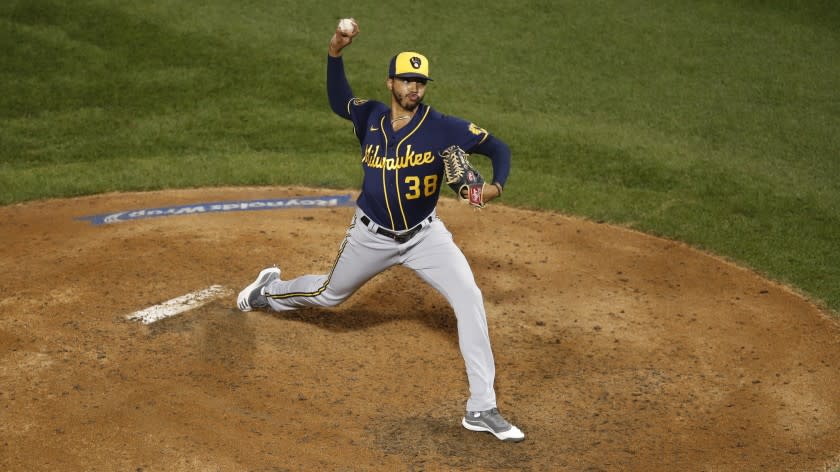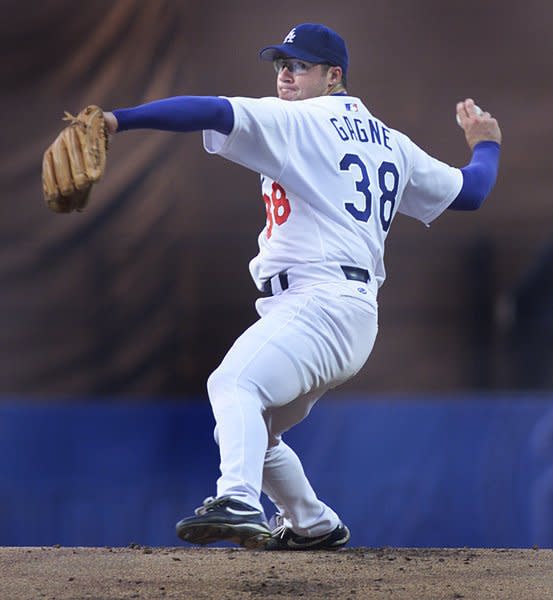Dodgers must contend with the unhittable 'Airbender' pitch of Brewers' Devin Williams

The pitch defies logic and description. It’s classified as a changeup but acts more like a screwball, the rare offering from a right-hander that fades down and away from a left-handed batter. Rob Friedman, known on Twitter as the Pitching Ninja, may have coined the best moniker for the pitch: the “Airbender.”
Whatever you call it, the Dodgers are going to have to deal with the pitch in their first-round playoff series against the Milwaukee Brewers, who will lean heavily on a deep and versatile bullpen that features a little-known rookie who has been even more dominant this season than left-hander Josh Hader.
Meet Devin Williams, a 26-year-old right-hander who went 4-1 with an 0.33 ERA in 22 games, striking out 53 and walking nine in 27 innings, a 17.67 strikeouts-per-nine innings rate that, in a 60-game season, tied Aroldis Chapman (2014 Reds) for the best single-season mark in baseball history.
The 6-foot-2, 200-pound Williams, a 2013 second-round pick who transitioned from starter to reliever at double-A Biloxi in 2019, allowed only one run all season, on a solo homer by Pittsburgh’s Colin Moran on July 27.
“I think Devin had a remarkable season, a really historic season, it’s absolutely incredible,” Milwaukee manager Craig Counsell said. “The strikeout numbers were special. It’s hard to comprehend a little bit, what he did.”
Williams has a lively fastball that averages 96.5 mph according to Fangraphs, a pitch he’s thrown 43.9% of the time, but his out pitch is a changeup that averages 84.1 mph and is thrown 52.7% of the time.
His signature pitch is thrown with a circle-change grip, but the pronation of his wrist as he releases the ball creates both left-to-right and downward movement. The 13-mph difference between the fastball and changeup, which he throws with similar arm action, disrupts the timing of hitters, who often flail at the pitch or take it for a strike.
If the pitch mix and usage sound familiar to Dodgers fans, it’s because Eric Gagne used nearly the exact same repertoire to become one of baseball’s best closers in the early 2000s, when he featured a 96-98 mph fastball and an 82-85 mph changeup with similar fading action.
Counsell, a former infielder who played most of his 16-year career with Arizona and Milwaukee, went hitless in 10 at-bats with three strikeouts against Gagne. Does Williams remind him of the former Dodgers closer who had a major league-leading 55 saves in 2003?

“I haven’t heard Eric Gagne’s name with him, but I actually think that might be the best comparison as far as the action on the changeup,” Counsell said. “It’s a similar action, with velocity, and that’s what Eric was doing in his prime, throwing a really good changeup but also big velocity [on the fastball].”
Williams held opponents to an .090 batting average and .339 on-base-plus-slugging percentage this season. His changeup made him even more effective against left-handers, who hit .075 against him, than right-handers, who hit .111 against him.
Williams can throw multiple innings in high-leverage spots, and he teams with Hader (1-2, 3.79 ERA, 13 saves in 21 games) to give Milwaukee a dynamic right-left, back-of-the-bullpen duo.
With ace Corbin Burnes (4-1, 2.11 ERA) sidelined by a left-oblique strain and left-hander Brett Anderson questionable because of a blister on the index finger of his pitching hand, the eighth-seeded Brewers (29-31) will need Williams, Hader and the rest of their relievers to cover the bulk of the innings against the top-seeded and heavily favored Dodgers (43-17).
“We’re not afraid to do things unconventionally,” Milwaukee general manager David Stearns said. “What Corbin did this year is the main reason why we’re still playing, so for him to not be able to pitch Game 1 of a playoff series is hard to take. It’s disappointing. But we have other guys who will need to step up.”
Adding bullpen depth are right-handers Eric Yardley (2-0, 1.54 ERA in 24 games), Justin Topa (0-1, 2.35 ERA in six games) and Drew Rasmussen (1-0, 5.87 ERA in 12 games). Topa and Rasmussen both throw 98-mph fastballs.
“Bullpens tend to be a little more volatile, but I think we found some pieces that are talented and have a chance to be parts of bullpens for multiple years,” Counsell said. “It’s a really good core group, for sure.”
Milwaukee’s best-of-three series against the Dodgers could very well resemble its seven-game National League Championship Series loss to the Dodgers in 2018, when Brewers relievers — mostly Brandon Woodruff, Hader, Corey Knebel and Burnes — threw 45 1/3 of the team’s 65 2/3 innings.
“We’ll piece it together like we usually do,” Milwaukee right fielder and 2018 NL most valuable player Christian Yelich said. “I think this is where the Brewers organization shines, in the postseason, getting creative … we’ve seen it in the past. I think we’ll find a way to have a great series.”

